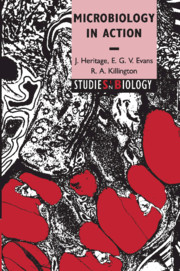Book contents
- Frontmatter
- Contents
- Preface
- 1 The microbiology of soil and of nutrient cycling
- 2 Plant–microbe interactions
- 3 The microbiology of drinking water
- 4 Microbial products
- 5 Food microbiology
- 6 The human commensal flora
- 7 Microbial infections
- 8 Chemotherapy and antibiotic resistance
- Further reading
- Glossary
- Index
Preface
Published online by Cambridge University Press: 05 June 2012
- Frontmatter
- Contents
- Preface
- 1 The microbiology of soil and of nutrient cycling
- 2 Plant–microbe interactions
- 3 The microbiology of drinking water
- 4 Microbial products
- 5 Food microbiology
- 6 The human commensal flora
- 7 Microbial infections
- 8 Chemotherapy and antibiotic resistance
- Further reading
- Glossary
- Index
Summary
When we wrote Introductory Microbiology some very hard decisions had to be made concerning the contents of the book. We were constrained by the style of the Studies in Biology series to write a book of no more than 200 pages. In the end, we decided that students needed a description of what microorganisms were and how they can be safely manipulated before appreciating what they can do. We therefore took the decision to base our first book on these fundamental aspects of the subject. We were convinced at the time, however, that we could fill a second book with the material that we had omitted from the first. All we had to do was to persuade a publisher that students need to know about much more than we could include in that book.
Tim Benton, who edited our Introductory Microbiology, was so pleased with our proposal that he accepted our ideas and then promptly left Cambridge University Press to take up an academic career. We are not suggesting that this career change has any bearing on Tim's ability to make rational decisions or on the viability of our proposals. The project was handed on to Barnaby Willitts. He was very supportive throughout the writing of this book. As the deadline for submission arose, however, Barnaby left the press (and the country). The project was then handed to Maria Murphy. We owe all those who played a part in producing this book a debt of thanks.
- Type
- Chapter
- Information
- Microbiology in Action , pp. xiii - xviPublisher: Cambridge University PressPrint publication year: 1999



